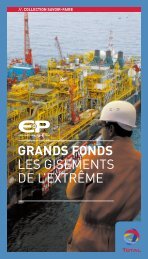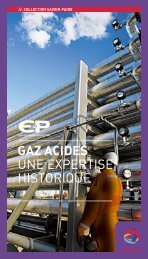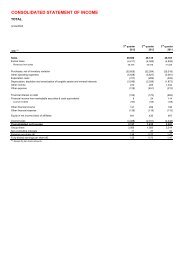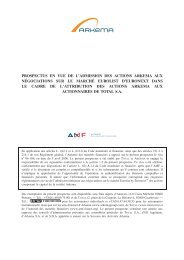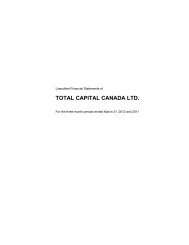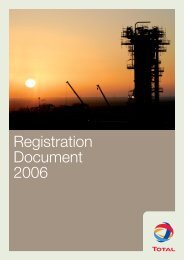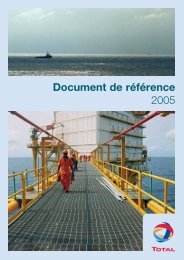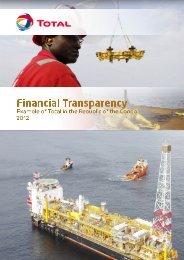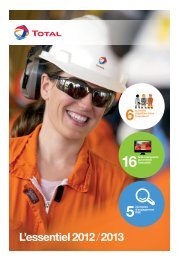Registration Document 2005 - Total.com
Registration Document 2005 - Total.com
Registration Document 2005 - Total.com
Create successful ePaper yourself
Turn your PDF publications into a flip-book with our unique Google optimized e-Paper software.
Adoption of IFRS rules<br />
The principal modifications of the Group’s accounting principles<br />
concern the following subjects:<br />
Inventories<br />
In accordance with IAS 2, the Group values inventories of<br />
petroleum products in the financial statements according to the<br />
FIFO (First-In, First-Out) method and other inventories using the<br />
weighted-average cost method.<br />
However, in the note setting forth information by business segment,<br />
the Group will continue to present the results of its Downstream<br />
segment according to the replacement cost method and those of<br />
its Chemicals segment according to the LIFO (Last-In, First-Out)<br />
method in order to ensure the <strong>com</strong>parability of the Group’s results<br />
with those of its leading <strong>com</strong>petitors, mainly in the United States.<br />
Inventory valuation using the FIFO method, which implies the<br />
cancellation of the reserve for crude oil price changes, is reflected<br />
by an increase in the value of inventories and an increase in<br />
shareholders’ equity as of January 1, 2004.<br />
Treasury shares<br />
In application of IAS 32 relating to financial instruments, treasury<br />
shares recorded under marketable securities in the financial<br />
statements prepared according to French GAAP have been<br />
eliminated from shareholders’ equity.<br />
Employee benefits<br />
The Group has decided to record unrecognized net actuarial losses<br />
and gains as of December 31, 2003 through retained earnings in<br />
accordance with IFRS 1.<br />
As of the transition date, the negative impact on shareholders’<br />
equity results from a decrease in other non-current assets (pension<br />
assets) and an increase of provisions for employee benefit<br />
obligations.<br />
The effect on net in<strong>com</strong>e under IFRS results from the cancellation<br />
of the amortization of actuarial gains and losses.<br />
Profit and loss account presentation<br />
The Group has chosen to follow the re<strong>com</strong>mendation of<br />
CNC (French accounting standard setter) # 2004-R02, dated<br />
October 27, 2004, for the presentation of its consolidated financial<br />
statements. This presentation allows the reconciliation of the<br />
in<strong>com</strong>e statement items with performance indicators as presented<br />
in note 4 to the consolidated financial statements (information by<br />
business segment).<br />
Management Report of the Board of Directors<br />
Summary of results and financial position<br />
TOTAL - <strong>Registration</strong> <strong>Document</strong> <strong>2005</strong><br />
3<br />
Sales of products or goods<br />
Henceforth, the indicator “sales” includes excise taxes collected by<br />
the Group in the course of its oil distribution operations. Sales net<br />
of excise taxes are shown as “Revenue from sales” according to<br />
IAS 18 “Revenue from ordinary activities”.<br />
Pursuant to IAS 1 “Presentation of Financial Statements”, certain<br />
transactions within the Trading sector previously reported under<br />
sales and purchases must now be shown at their net value in sales.<br />
This restatement leads to a reduction of 22.2 billion euros in sales<br />
as well as cost of goods sold.<br />
Operating expenses<br />
The breakdown of operating expenses, which is shown in note 6<br />
to the consolidated financial statements, now appears directly<br />
on in<strong>com</strong>e statement and includes the following headings:<br />
purchases, net of inventory variation, other operating expenses and<br />
unsuccessful exploration costs.<br />
Financial in<strong>com</strong>e<br />
Financial in<strong>com</strong>e is henceforth broken down as follows: one part,<br />
the cost of the net debt, including financial expenses related to<br />
indebtedness (financial interest on debt) are distinguished from<br />
financial in<strong>com</strong>e (in<strong>com</strong>e from marketable securities and cash<br />
equivalents) as an offset, and another part, in<strong>com</strong>e and expenses<br />
unrelated to debt.<br />
Other IFRS restatements<br />
The other restatements at the transition date are as follows:<br />
Amortization of goodwill<br />
Pursuant to IFRS 3 “Business <strong>com</strong>binations”, goodwill is no longer<br />
amortized. Instead, it is tested for impairment annually.<br />
Share-based payments<br />
The Group applies IFRS 2 “Share-based payments” as published<br />
by the International Accounting Standards Board (IAS B). This<br />
standard applies to employee stock-option and share purchase<br />
plans and to capital increases reserved for employees retroactively<br />
and not solely to the share transactions that were granted after<br />
November 7, 2002.<br />
These employee benefits are recognized as expenses with a<br />
corresponding credit to shareholders’ equity.<br />
The cost of options is valued according to the Black-Scholes<br />
method and allocated on a straight-line basis between the grant<br />
date and vesting date. For employee-reserved capital increases,<br />
the cost is immediately recognized as an expense.<br />
69




